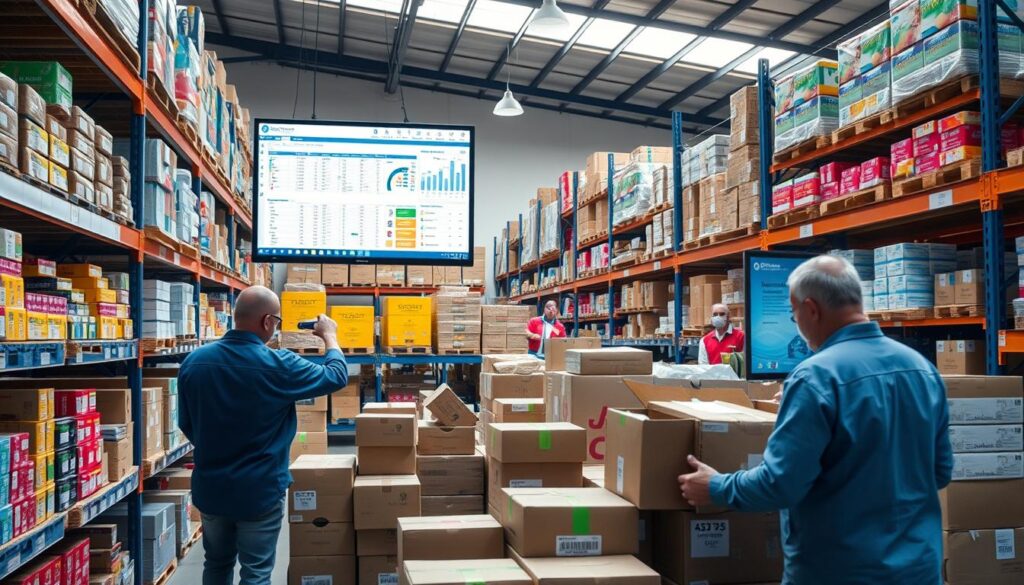I found a vintage leather jacket at a thrift store for $20. Within a week, I sold it online for $150. This sparked my journey into reselling products.
The thrill of finding deals and flipping items became addictive. Soon, I was making $100 a day through online reselling. Reselling could be your ticket to financial freedom.
The resale market is booming, especially in secondhand apparel. It’s expected to grow from $36 billion in 2021 to $77 billion in 2025. Now is the perfect time to start reselling.
You can flip clothes, electronics, or vintage finds for substantial earnings. This guide will show you how to make $100 daily through reselling.
We’ll cover finding the best items to flip and pricing strategies. You’ll also learn how to build a loyal customer base. Turn your eye for deals into a profitable side hustle or full-time gig.
Key Takeaways
- Reselling products can generate $100 or more daily with the right strategies
- The secondhand market is growing rapidly, offering ample opportunities
- Popular resale items include clothing, electronics, and vintage finds
- Online platforms like eBay and Facebook Marketplace are ideal for reselling
- Successful reselling requires skills in sourcing, pricing, and customer service
- Resale can be a profitable side hustle or full-time business opportunity
Understanding the Resale Business Model
The resale business model focuses on flipping items for profit. It’s a straightforward concept: buy low and sell high. This strategy has gained traction, with resale marketplaces becoming hubs for entrepreneurs.
What is Product Flipping?
Product flipping means buying items cheaply and reselling them at higher prices. This practice covers many product types, from clothes to electronics. Successful flippers often focus on niche markets.
They build expertise in their chosen areas. This helps them attract loyal customers over time.
Market Size and Potential
The resale market is thriving. Over 223 million consumers are open to buying used items. The sneaker resale industry alone is worth $2 billion in the U.S.
eBay, a popular platform for resellers, handles over 2 billion transactions daily. This shows the vast potential in this market.
Current Industry Trends
Sustainability is fueling growth in the resale sector. More consumers are choosing secondhand items, creating opportunities for flippers. Online marketplaces are growing, offering diverse options for resellers.
Some platforms, like eBay, have flexible seller rules. This makes it easier for newcomers to start their resale business.
“Starting a reselling business can be done with as little as $500 in upfront capital.”
The industry keeps evolving, despite challenges like Nike’s new reselling rules. Resellers are adapting by joining networks and using “cook groups” for insider info.
They’re also using catchall emails to bypass quantity limits. As the market expands, so do opportunities for those ready to flip items.
Essential Tools and Resources to Start Reselling
Resale businesses need the right tools and resources to succeed. Platforms like eBay, Amazon, and Facebook Marketplace are crucial for reaching customers. These sites offer large audiences and easy-to-use interfaces for listing products.
Managing inventory is key for success. Digital spreadsheets help track finances and stock levels. Clothing racks organize items and make photography easier. A good smartphone camera is vital for creating high-quality listings.

Sourcing inventory is critical in reselling. Thrift stores, wholesale suppliers, and online deals are great places to find products. The vintage clothing market is growing 3% yearly from 2022 to 2027.
- Fabric shaver: Extends garment life and increases resale value
- Cloth tape measure: Ensures accurate measurements for listings
- Lint roller: Removes hair and debris from clothing
- Packing supplies: Improves shipping efficiency
- Thermal label printer: Cost-effective for printing shipping labels
Online tools help find profitable items across platforms. They compare prices and analyze trends, giving resellers an advantage in sourcing inventory.
The global secondhand apparel market was valued at $197 billion in 2023 and is projected to reach $350 billion by 2028.
These tools and resources will help you start reselling. You’ll be ready to tap into the growing market for secondhand goods.
How to Make $100 Per Day with Resale
Smart resale can be highly profitable. Focus on high-margin items and efficient sourcing. This approach can help you build a scalable business earning $100+ daily.

Setting Realistic Profit Goals
Look for items with strong profit margins. Flipping electronics can yield significant returns. One reseller bought electronic boards for $8 and sold them for $2,500 on eBay.
Daily Action Plan
Create a structured routine to maximize your earnings:
- Source products from thrift stores, yard sales, or online marketplaces
- List items on multiple platforms to increase visibility
- Respond promptly to customer inquiries
- Package and ship sold items efficiently
Income Tracking Methods
Keep detailed records of your transactions. This helps you understand your business performance. Track the following:
- Purchase price of items
- Selling price and platform fees
- Shipping costs
- Net profit per item
Reinvest profits and refine your strategies to scale your business. Success comes from smart sourcing and efficient selling. Stay updated on market trends to improve your resale game.
“The resale industry is booming,” says Yulia Vershagina, director of marketing at Treet. This growth presents ample opportunities for savvy resellers to thrive in the market.
Best Platforms for Reselling Products
Online marketplaces offer great opportunities for making money. Choosing the right platform is key to your reselling success. Let’s look at some top options for boosting your profits.
Online Marketplaces Overview
eBay is a top choice for resellers with 1.21 billion monthly visits. It’s great for selling various items, from collectibles to electronics.
Amazon offers a huge customer base for sellers. However, sellers may wait up to 90 days for payment in some cases.

Social Media Selling Platforms
Facebook Marketplace is popular for local and online sales. It’s easy to use and doesn’t charge listing fees.
Instagram Shopping lets businesses tag products in posts and stories. This feature makes it simple for followers to buy items directly.
Local Selling Applications
Mercari and OfferUp are great for local transactions. Mercari has about 20 million monthly users and 350,000 new items listed daily.
These apps work well for items that are hard to ship. They’re also good when you prefer in-person sales.
“Choose your selling platform wisely. Each has its strengths and target audience. Match your products and business goals with the right marketplace for success.”
Fees and policies differ across platforms. eBay charges a final value fee on sales. Etsy requires a listing fee for all items.
Consider these factors when deciding where to sell. The right choice can help your business thrive.
Most Profitable Items to Flip
Success in resale hinges on finding profitable items. Some products consistently yield high returns. Let’s explore lucrative options for resellers.
Event tickets are a goldmine, generating over $80 billion yearly. Music events offer great profit potential. Luxury handbags, like the Hermes Mini Kelly, can fetch astronomical prices.
Collectibles are another hot market. Rare Funko Pops can resell for hundreds or thousands of dollars. Limited-edition sports cards have a thriving resale market.
- Graphics cards (GPUs) are in high demand for gaming, AI, and cryptocurrency mining
- Vintage electronics and cameras often have high price-to-size ratios
- Designer clothing and accessories can yield significant profits
Real-life success stories showcase flipping’s potential. One reseller made $1,200 in a day with just two items. A $30 pitching machine investment resulted in a $570 profit.
A $10 Cadillac subframe sold for $800, netting $790.
“Aim for 10x profits when flipping items. It’s not just about finding profitable resale items; it’s about maximizing your return on investment.”
Focus on high-margin items where profits significantly exceed costs. Explore niche markets like limited-edition cars or exclusive merchandise. Timing is crucial – selling at the right moment can boost profits.
Sourcing Inventory for Maximum Profit
Product sourcing is crucial for a successful resale business. To earn $100 daily, find items that sell fast with good profit margins. Let’s explore effective inventory sourcing strategies.
Thrift Store Strategies
Thrift store flipping can be highly profitable. Aim to pay about $2 per item on average. Some stores charge by the pound, from $1 to $3.
For luxury brands, it’s okay to pay more. Buying a Madewell bag for $10 and selling it for $40 is a great deal.

Wholesale Purchasing Tips
Wholesale buying allows bulk purchases at discounted rates. Use tools like RevSeller to calculate profits and check sales ranks. Look for items with 100% ROI when starting out.
As you gain experience, consider items with 75% or 50% ROI. Remember to factor in fees and competition when deciding.
Online Arbitrage Methods
Online arbitrage means finding discounted products on one platform to sell on another. Use apps like Scoutify to scan inventory and analyze sales factors.
Avoid items sold by Amazon. Look for products with fewer competitors to increase your buy box chances.
To reach your $100K yearly goal, aim for $100 daily from three categories. Diversify your expertise across multiple niches to boost earnings.
Success in reselling comes from dedication, expertise, and a solid strategy. Keep learning and adapting to market changes.
Pricing Strategies That Drive Sales

Smart pricing can make or break your resale business. Research prices of similar items to set competitive rates. Consider factors like condition, rarity, and demand when pricing products.
Dynamic pricing is a powerful tool for resellers. It lets you adjust prices based on market trends and competition. You can raise prices during peak seasons or lower them during slow periods.
“Pricing is not just about numbers, it’s about creating value for your customers.”
Boost average order value with bundle deals or quantity discounts. This approach encourages customers to buy more while feeling they’re getting a good deal. Successful pricing balances profit maximization with maintaining a competitive edge.
- Research market prices
- Use dynamic pricing
- Offer bundle deals
- Balance profits and competitiveness
These pricing strategies can drive sales and increase profit margins. Stay ahead by adapting your pricing as market conditions change. This approach ensures long-term success in the resale business.
Building a Reliable Customer Base
A solid customer base is vital for resale success. It’s about creating lasting relationships, not just making sales. Let’s explore how to excel in customer service and manage your reputation effectively.
Customer Service Excellence
Great customer service is crucial for any successful business. Respond quickly to inquiries and be polite. Happy customers often become repeat customers.
Your reputation can make or break your resale business. Always go the extra mile for your customers.

Repeat Buyer Programs
Loyalty programs can significantly boost your sales. Offer exclusive deals or early access to new items for repeat buyers. This encourages customer loyalty and maintains steady sales.
Creating a profitable home business often relies on nurturing these relationships. Focus on building strong connections with your customers.
Reputation Management
Your online reputation is crucial in the resale business. Actively manage your seller ratings and reviews. Address negative feedback promptly and professionally.
Encourage satisfied customers to leave positive reviews. A strong reputation attracts new buyers and keeps existing ones returning.
- Respond to all customer feedback
- Resolve issues quickly and fairly
- Showcase positive reviews on your platforms
Focus on these areas to build a loyal customer base. Your reputation management efforts directly impact your bottom line. Prioritize customer satisfaction to ensure long-term success.
“The customer’s perception is your reality.” – Kate Zabriskie
Managing Inventory and Operations
Effective inventory management is crucial for scaling a resale business. It ensures the right products are available at the right time. A solid system helps track stock levels, avoid overselling, and streamline operations.

Organizing your storage space is key. Create a system to easily locate and ship items. This saves time and improves efficiency in daily operations.
Consider categorizing inventory into A, B, and C groups. This method helps prioritize management efforts based on value and consumption.
Inventory management software can be a game-changer. These tools automate tasks, improve accuracy, and provide real-time analytics. Square for Retail offers software that syncs across multiple channels.
- Enable item tracking
- Set up alerts for low-stock items
- Use bulk import tools for updating quantities
Consider consignment as a strategy for scaling your resale business. It allows stocking products without upfront costs. Typically, it involves a 20-60% commission on final sales.
Consignment helps test market viability with minimal risk. It also provides exposure for your business.
Effective inventory management optimizes your entire resale operation. It supports growth and profitability. Implementing these strategies will position your business for efficient scaling.
Marketing Your Resale Business
Effective marketing is crucial for resale success. Let’s explore powerful techniques to boost your business.
Social Media Marketing
Social media platforms are game-changers for resellers. Instagram and Facebook offer great opportunities to showcase your products. Post high-quality photos of your items and engage with potential buyers.
Interact through comments and direct messages. Consistency is key in social media marketing.

Content Creation
Content marketing can set you apart in the resale world. Create engaging blog posts, videos, or infographics about your products. You could make a video showing how to style a vintage jacket.
Another option is writing a blog post about a collectible item’s history. This content adds value for customers and drives traffic to your listings.
Email Marketing Strategies
Email marketing nurtures customer relationships. Build an email list and send updates about new inventory and special promotions. Personalize emails based on customers’ past purchases to increase engagement and sales.
Successful resale marketing combines social media, content creation, and email strategies. By implementing these approaches, you can attract more buyers and grow your business.
“In my first year of reselling, I had a turnover of nearly $120,000, with an estimated profit of about $40,000. Effective marketing was key to this success.”
Legal Requirements and Business Structure

Starting a resale business requires understanding legal requirements and choosing the right structure. The global secondhand market was worth $197 billion in 2023. Success in this field depends on grasping these crucial elements.
Research local and state regulations for resale business legal requirements. Obtain necessary licenses and permits. Many states have specific documentation needs for legal operation.
Selecting a business structure is vital. Sole proprietorships are great for side hustles with minimal paperwork. LLCs offer more protection by separating personal and business finances.
Taxes play a big role in resale. You need to:
- Collect and report sales tax
- Keep accurate transaction records
- Understand income tax obligations
Open a separate business bank account to manage finances effectively. This helps track income and expenses for tax purposes.
Get liability insurance to protect against potential legal issues. It can cover costs if accidents happen during business operations.
Proper planning is key. Starting a resale business with solid legal foundations sets you up for long-term success. This growing industry offers great opportunities for those who prepare well.
Scaling Your Resale Operation
Growing a resale business requires smart strategies and efficient tools. You’ll need to streamline processes and expand your reach. Let’s look at some key methods to boost your resale venture.
Automation Tools
Automation tools are essential for resellers. They handle listing creation, inventory management, and customer communication. These tools free up time for sourcing products and business growth.
Many successful resellers use software to cross-post listings. This saves hours of manual work across multiple platforms.
Hiring Virtual Assistants
Virtual assistants can scale your operation cost-effectively. They handle tasks like product research, customer service, and order processing. This approach maintains a lean operation while expanding capacity.
With virtual assistants, you can focus on high-value activities. These activities drive growth and improve your business.
Expanding Product Lines
Diversifying your product offerings is key to scaling. Consider branching out into new categories or niches. This can help you tap into new markets.
JV Ortiz started flipping t-shirts for $10 profit each. He scaled to selling sneakers, making $10,000 a month.
Scaling a resale operation is about working smarter, not harder. Use automation tools, virtual assistants, and diverse product lines. This approach helps grow your business without burnout.
Keep analyzing market trends and adjusting your strategy. This ensures sustainable growth in the competitive resale market.
Common Reselling Mistakes to Avoid
The resale business can be challenging. Richard S., owner of top-ranked eBay store Technsports, shares valuable insights. He stresses knowing market demand over personal preferences when choosing inventory.
A major mistake is creating a ‘death pile’ of unsold items. This ties up money and misses sales chances. Make a schedule for sourcing, listing, and packing to avoid this problem.
Spend time daily checking “sold items” in your category. This helps you understand what sells well. Pricing strategies are crucial too.
A regular Nike Dri-FIT shirt might sell for $10-$20. Items with famous athlete logos could fetch $30-$70 or more. Avoid overpricing or underpricing by doing thorough research.
Remember, strategies differ across platforms. On Poshmark, follower count doesn’t directly affect sales. Focus on listing in-demand items to attract buyers and boost success.

